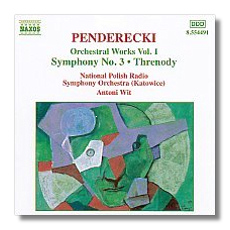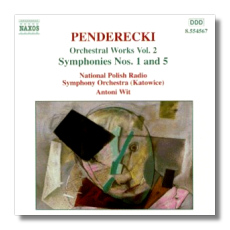
The Internet's Premier Classical Music Source
Related Links
- Penderecki Reviews
- Latest Reviews
- More Reviews
-
By Composer
-
Collections
DVD & Blu-ray
Books
Concert Reviews
Articles/Interviews
Software
Audio
Search Amazon
Recommended Links
Site News
 CD Review
CD Review
Krzysztof Penderecki

Orchestral Works, Volume 1
- Symphony #3
- Threnody for the Victims of Hiroshima
- Fluorescences
- De natura sonoris II
National Polish Radio Symphony (Katowice)/Antoni Wit
Naxos 8.554491 DDD 77:25


Orchestral Works, Volume 2
- Symphony #1
- Symphony #5
National Polish Radio Symphony (Katowice)/Antoni Wit
Naxos 8.554567 DDD 68:06
Naxos' six-CD retrospective of Witold Lutosławski's orchestral works is one of the best things that this label has done. Now Naxos, along with the same orchestra and conductor, is turning its attention to the orchestral music of another modern Pole: Krzysztof Penderecki. Penderecki was born in 1933, 20 years after Lutosławski. Unlike his predecessor, he still is alive and composing, although in a style that is markedly different than that which earned him his initial fame around 1960. International attention arrived with Threnody for the Victims of Hiroshima – the title was added after the piece was completed. Scored "for 52 stringed instruments," it is a scarifying wall of sound. Penderecki treats the strings like percussion instruments, and conjures wild noises out of them using non-traditional playing techniques. It is a wail, a scream, a sinister muttering, and an orgy of air-raid sirens all in one. Fluorescences, written the following year, out-assaults the Threnody. Here, Penderecki writes for full orchestra, and includes instruments not formally found in an orchestra, including a typewriter (pace Leroy Anderson!); pieces of wood, tin, and glass; and (this time for real) a siren. De natura sonoris II, written a decade later, finds Penderecki refining his sonorist concept. The sounds no longer shock, but they still have the power to provoke debate on whether music can be defined as the organization of noises.
Volume 3 [shortly to be issued on Naxos 8.554492] contains the Second and Fourth Symphonies. Considering Volumes 1 and 2 together, one nevertheless can trace the changes in Penderecki's style through his symphonies alone. The 30-minute First Symphony, written in 1973 for an English engine factory, shows that the composer's sonorist techniques are amenable to symphonic development. Although it is less extreme than the works described above, it still is the work of a composer for whom experimental curiosity is at the fore. By the time of the Third Symphony (begun in 1988, but not completed until 1995), Penderecki has returned to a more traditional language. Striking orchestral sonorities are used, but as a means to expression rather than as an end. The music is tough and biting, but perhaps not as concentrated as it might be. The Fifth Symphony (1992) is even more removed from the sound-world of the Threnody. Here, Penderecki is writing music that would not be out of place in a symphony by Allan Pettersson. The mood is dark and reminiscent of the symphonies of Mahler and Shostakovich. The Fifth Symphony, the composer's most recent, alternates between driving intensity and bitter brooding. In the 60s and 70s, Penderecki may have come to feel that his compositional techniques had taken him as far as he cared to go. His music has remained essentially pessimistic, however.
Wit studied with Penderecki, and also with Henryk Czyz, a conductor who premièred some of Penderecki's music. He is at his best in the symphonies, favoring tempos that are a faster than the composers own, and emphasizing structure in music that tends to be a little loose in this department. He and the Polish orchestra seem a bit inhibited in the shorter works; earlier recordings by the composer and Andrzej Markowski took more pleasure in sound qua sound. Nevertheless, those recordings are difficult to find, and there is a definite need for these new versions. The Naxos Penderecki project is in good hands, and I am waiting to see whether it will extend to the choral works as well. (Kosmogonia, with its fascinating texts alluding to the creation and exploration of the universe, really needs to find its way to disc.) The engineering is good, but not as detailed as I would like it to be.
Copyright © 2000, Raymond Tuttle


















